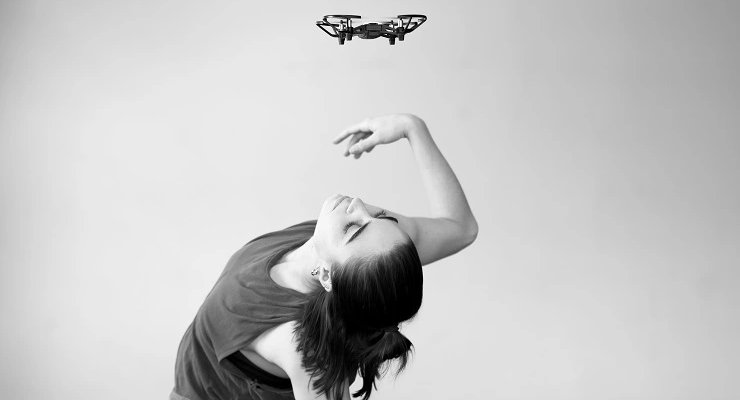
Picture two dancers moving in lockstep. Call it rumba, tango, foxtrot, or waltz, they flirt, lead and feed off each other’s movements.
Now replace one of those dancers with a buzzing drone, and afford this dynamic duo the same energy, intensity, and intimacy as the two cavorting individuals.
To do so requires a combination of cutting-edge science and creative cut-through.
The Australian National University’s new cybernetics centre opens today with an exhibition of 100-plus pieces of art, old and new, that unpacks the relationship between systems, humans, and their surroundings. It’s an industry-meets-art affair not seen since former prime minister Scott Morrison folded the federal arts department into Infrastructure back in 2019.
Coined a “first of its kind”, the school is on a mission to understand how humans and machines can operate in the same space. It will try, test, and roll out all manner of new systems streetside, on the land, in the air, and underwater in a bid to better bridge what some see as a terrifying transition to a technologically inclined world.
“There’s this discomfort around what our future looks like in an AI [artificial intelligence] world,” artistic director at the Australasian Dance Collective Amy Hollingsworth told Crikey. “I’m trying to show our potential to move in a much more spatially empathetic way.”
Hollingsworth is at the helm of a cybernetics research and performance piece where six Australian dancers and five unpiloted Swiss drones take the stage together. It’s titled “Lucie in the Sky” and unpacks what it means to be human, what it means to be seen to be human, and what’s required for a system to take on human emotion.
A big part of that is redefining the way that humans perceive machines. Rather than simply fit-for-function, it’s plausible for a machine to have a personality. Call it “emotional coding”.
Meet the crew
The cast comprises 11 unique characters, all with agency, that are either rehearsed (dancer) or pre-programmed (drone) to move in a certain way. The battery life of a drone is only two minutes and 20 seconds so it’s a matter of “multiple children to play one child”.
The title role is Lucie, “the empath”, a shy and emotional drone that is incredibly attached to one of the human characters. The sage of the piece is a nameless sad drone coded to channel “big Eeyore vibes”. Red is the feisty, cross and cranky drone that comes from a place of intense feeling. Skip is the crowd favourite — a happy, boisterous, somewhat overexuberant, slightly naughty drone. And last is the (not yet named) leader, the calmest and most measured of the drones.
“The leader is definitely not modelled on some of our existing role models in the public,” Hollingsworth said.
The “cyber-physical” cast is diverse on paper, but just how does a 50g piece of plastic project its personality in practice?
The characters are communicated through the speed, height, and intensity of their flight paths. Lucie plays with proximity to show shyness. The sad drone flies low and slow, while Skip — full of beans — has “permission to fly fast”.
“We even tried to make Skip laugh on stage by bouncing it up and down erratically,” said Hollingsworth.
Another lever is light. Red comes with an on-brand (red) light source that flares up when the drone is enraged, while the leader uses light to guide the performers through the space.
It takes two to tango
The characters portrayed by the human dancers include the Caregiver, Artist, Seeker, Innocent, Hero, and Magician.
Harrison Elliot is the dancer who plays Skip’s human partner in crime. He goes by the name Magician and described the on-stage relationship between dancer and drone as “a bit of banter, a bit of playful back and forward, a bit of trickery, a bit of push and shove, and a bit of a laugh”.
“They had so much more character than I initially thought they would. Being in spaces with them and having them interact directly towards you or with you, you really get a sense that this thing has a personality,” Elliot said.
“It’s like Skip was a dog and you wanted to rough its ears up and get it to follow you around. Almost immediately there was a sense of companionship.”
Compare that with the power and gravitas of the leader drone, which Elliot found at times to be intimidating.
“In facing off with that kind of drone you do get a sense of its power and as a human that’s kind of confronting. You immediately start thinking ‘What are my limitations to this drone?’ It might be able to move faster or higher or have a capability that I don’t but at the same time, my power is also in my ability to adapt.”
These drones have agency. It’s not one-drone-fits-all.
The purpose of the performance is to illustrate how the get-to-know-you game between human and system is no different from a regular relationship: the “read” on a counterpart, colleague, comrade, or companion cannot come from a manual, it requires a live back and forth. Call it a dance.
Pairing the perfect and imperfect
Much of the current discussion about machines in human environments or human roles relates to their propensity to make mistakes. But Elliot said the difficulty of dancing with a drone stems less from its minimal margin of error and more from its inability to respond to human error.
“The drones are programmed to do the same thing every time. They are exceptionally consistent and we as humans are completely fallible and inconsistent by comparison,” he said.
The dancing drones are near but not completely perfect. Although highly accurate on the x and y plane (forward, back, left, right), on the z axis (up and down) they shan’t say no to stimulants such as heat. Hollingsworth described these as “happy accidents” that served a creative input.
“One time, Skip was programmed a little quicker than expected so Harrison had to dodge the drone. We then leaned into that with a sequence where the two of them dodged each other,” said Hollingsworth.
It’s on the dancers to develop a spatial awareness of the machine and facilitate a space in which it can perform its prescribed function. Elliot described it as creating a common tongue: “It’s been really interesting not only getting to know the drones pathways, but also getting to know the programmers because they look at it in such a different language to us. For them, it’s programming and numbers and pathways. For us, it’s movement and emotion and context.”
Making moves
The performance piece comes to life next May but will preview as a simulation at the ANU tomorrow. Unfortunately, the university was unable to secure a licence to fly the drones indoors.
In the interim, rehearsals continue with broomsticks or substitute dancers pretending to be drones.








A moral hazard emerges as AI simulates human intentional states by token of multiplication of possible harm, but balanced by possible good, but counterbalanced by known unknowns (like will AI choose the good).